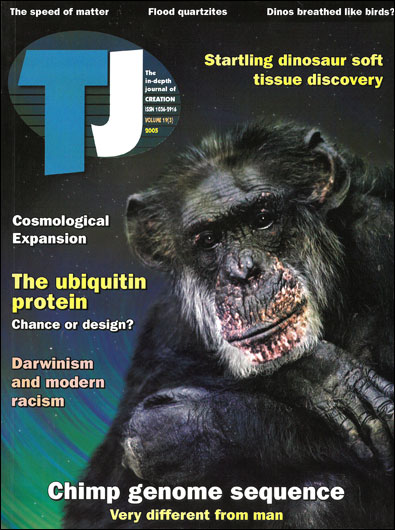Journal of Creation 19(3):13, December 2005
Browse our latest digital issue Subscribe
Was Lucy bipedal?
In the alleged process of humans evolving from primates, evolutionists have considered the most important event to be the evolution of bipedal locomotion. This event is even more important than the enlargement of the brain or the fabrication of stone tools. In fact, in many evolutionary scenarios, bipedalism is thought to be the cause of the enlargement of the brain and stone tool making.
The discovery of ‘Lucy’ (Australopithecus afarensis) in 1973 by Carl Johanson’s team, and the discovery of the Laetoli Footprints in 1978 by Mary Leakey’s team, both dated at more than three million years, was welcome confirmation to evolutionists of the early evolution of bipedalism. They based their case on the fact that A. afarensis fossils were also found at Laetoli, and that the only fossil reconstruction of the A. afarensis foot was arched, and hence compatible with the Laetoli Footprints. Thus, for over twenty years we have been told, both in the scientific and in the popular literature, that Lucy was bipedal and that she is what our evolutionary ancestor at that time looked like—or close to it.
Finally, a report in the August 2005 Scientific American suggests that there might be a problem. William E.H. Harcourt-Smith (American Museum of Natural History) and Charles E. Hilton (Western Michigan University) challenge Lucy’s bipedality. They claim that the fossil reconstruction of the A. afarensis foot is based on a mixture of fossils, some from the 3.2 million year old A. afarensis collection, and some from the 1.8 million year old Homo habilis collection. Specifically, they claim that one of the bones, the navicular, used to determine that the A. afarensis foot was arched, actually was a Homo habilis fossil foot bone, not an A. afarensis fossil foot bone.
Presenting their findings at the seventy-fourth Annual Meeting of the American Association of Physical Anthropologists in Milwaukee, 6–9 April 2005, these researchers state again what has been known for years—that the Laetoli Footprints are virtually indistinguisable from modern arched footprints made by humans who are habitually unshod.
Harcourt-Smith and Hilton then studied the naviculars of A. afarensis, H. habilis, chimpanzees, and gorillas. The measurements of the H. habilis navicular were within the modern human range. The A. afarensis navicular, on the other hand, was very much like that of the flat-footed apes, meaning that it was very unlikely that A. afarensis had an arched foot, as humans have. They conclude that ‘A. afarensis almost certainly did not walk like us or, by extension, like the hominids at Laetoli.’1
My personal file of scientific articles on A. afarensis bipedality is very thick. Yet, in over twenty years, to my knowledge, no evolutionist until now has mentioned that the relationship between the A. afarensis foot, the Laetoli Footprints, and thus the ‘proof’ of A. afarensis bipedality was based upon a faulty reconstruction. It is hard for me, an outsider, to know whether or not this is a case of outright deception. Was this matter known, but not mentioned, by paleoanthropologists generally? Or was it known by only a very few who were involved in the reconstruction of Lucy’s foot? It is certainly a striking example of the failure of evolutionists to inform the public regarding the actual state of the evidence in the most important ‘alleged event’ of human evolution. I have documented elsewhere many other cases of shabby scholarship or outright deception by evolutionists.2
It is significant that bipedalism authority, C. Owen Lovejoy (Kent State University), does not dispute the fact that the A. afarensis fossil foot reconstruction consists of bones from several different species. In spite of this problem, he defends Lucy’s bipedality by saying that even flat-footed modern humans can walk normally.
Harcourt-Smith and Hilton call for a new fossil foot reconstruction based only on A. afarensis fossils in order to determine whether or not A. afarensis was truly bipedal. If not, they suggest two other possibilities:
- that a fossil species known as Australopithecus anamensis made the Laetoli footprints, even though we have no fossil foot bones of this species, or
- that the Laetoli footprints were made by a species yet undiscovered.
For evolutionists, it’s just a short step from science to science-fiction.
References
- Wong, K., Footprints to fill, Scientific American, pp.18–19, August 2005.
- Lubenow, M.L., Bones of Contention: A Creationist Assessment of Human Fossils, Revised ed., Baker Book House, Grand Rapids, MI, Chapters 1 to 5, 2004.



Readers’ comments
Comments are automatically closed 14 days after publication.